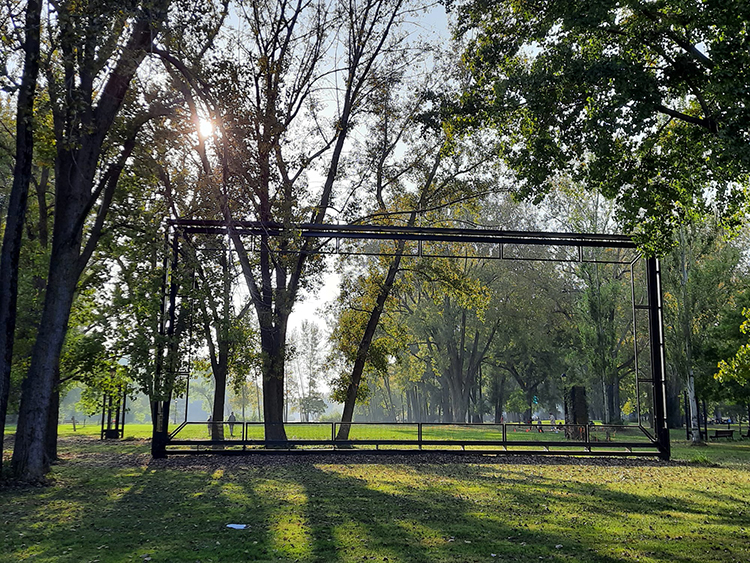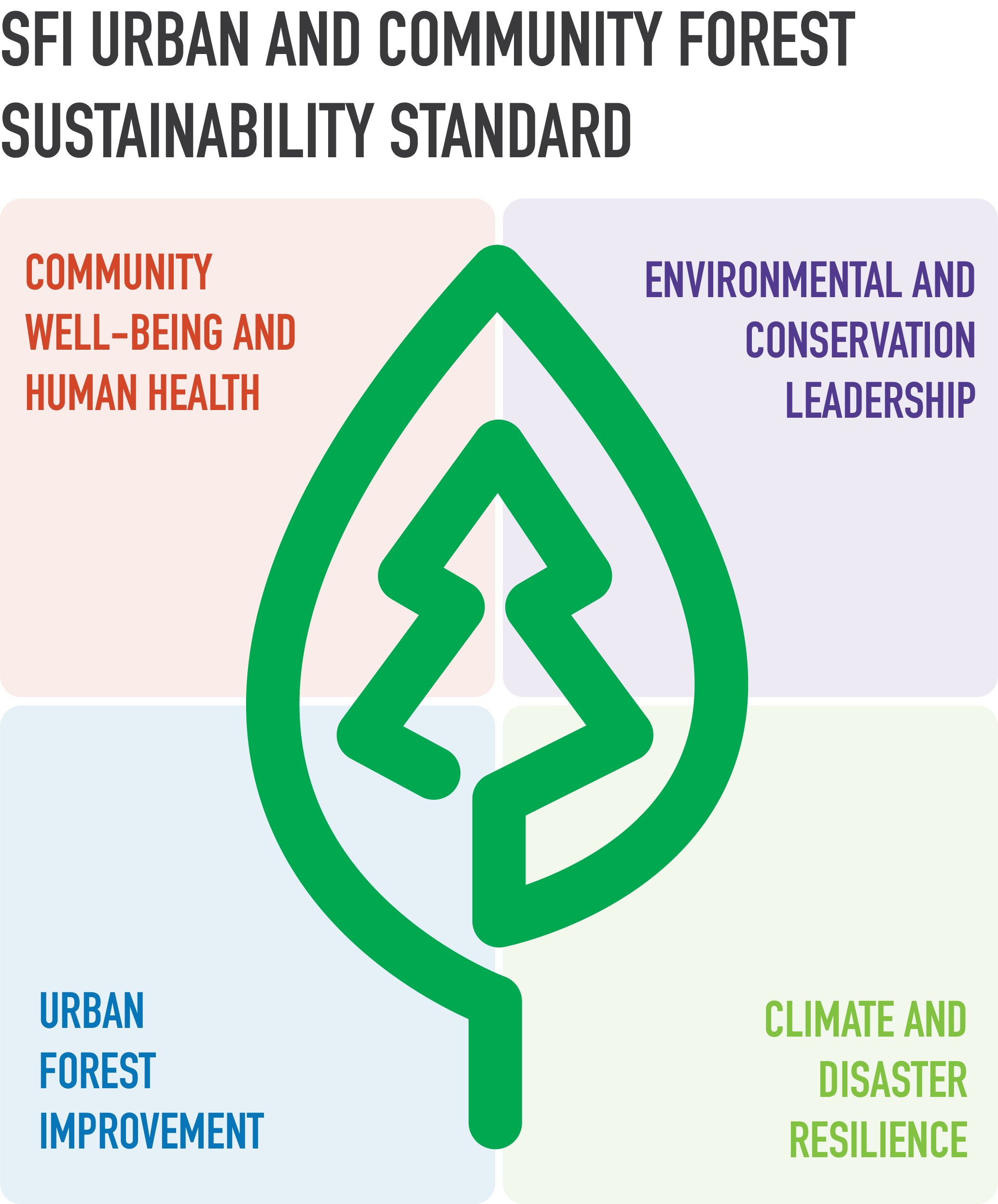By Meagan (Meg) Hanna, Director of Urban and Community Forestry for Canada
The trees where we live provide so much for our communities. Their shade cools us in summer. Trees purify the air we breathe. Birds build nests in city trees and bring us joy with their song. Our children play among trees in parks. When we walk in our urban green spaces, our stress, heart rate, and blood pressure go down. Researchers are even interested in the positive relationship between students being around trees and succeeding at school.
Regional and municipal governments represent just one of many groups caring for the trees that enhance our urban surroundings. Sustainability professionals at school and hospital campuses, corporate complexes, industrial facilities, and public gardens all play a role in caring for the land. They have the opportunity to plant and nurture many trees for community well-being. These urban forests and the workers who tend them can benefit from a strong network and better resources to support sustainability efforts. Moreover, a long-term vision for the management and care of our trees can serve our society while helping professionals set goals and track their accomplishments.

Urban forests, like the above Angrignon Park in the City of Montreal, deliver many benefits for Canadian communities.
In the summer of 2023, the Sustainable Forestry Initiative (SFI) launched the first of its kind SFI Urban and Community Forest Sustainability Standard. As a non-profit dedicated to a future where all value and benefit from sustainably managed forests, we see a great opportunity to provide leadership and raise the profile of trees and forests as nature-based solutions. Urban and community forests boost human health, make green space access more equitable, and strengthen environmental sustainability for our communities. This standard was developed collaboratively by leaders across all facets of urban and community forestry. As a result, the standard provides a vision to all on what it means to manage an urban or community forest in 2023. This resource also provides a roadmap on how we can ensure our trees thrive and provide for future generations.
In my new role as Director of Urban and Community Forestry for Canada at SFI, I aim to engage our urban forest stewards to embrace this new standard from coast to coast to coast!
The Values and Benefits of Sustainably Managed Urban Forests
My commitment to the quality of urban green spaces began in the community where I grew up: Montreal. Starting at age 19, to support my studies at John Abbott College and McGill University, I worked for five seasons, tending to the parks and green spaces of the Town of Mount Royal. Among my jobs, I helped care for the Pierre Elliott Trudeau Rose Garden, named for the former prime minister and local Member of Parliament. As I graduated from university, my heart pulled me towards caring for our urban green spaces when the City of Montreal hired me as a technical officer for horticulture and arboriculture. I reoriented my career from seeking to work in museums and cultural heritage to pursuing a certificate in horticulture and green space management at Université Laval. Several years later, my career path came full circle when I had the privilege of working as Living Collections Supervisor for the Montreal Botanical Garden, part of Canada’s largest scientific museum complex, Space for Life.

Meg Hanna presents the new SFI Urban and Community Forest Sustainability Standard at the Forests Ontario Annual Conference.
In 2011, my journey brought me to St. Leonard, a borough on the east side of Montreal, where I discovered an issue much bigger than beautiful communities and horticultural excellence: managing an urban forest and ramping up a tree planting program. With just a nine percent tree canopy, St. Leonard needed more trees—but threats abounded. The emerald ash borer had arrived to decimate thousands of ash trees across the island. Moreover, urban development meant that mature trees would be removed to accommodate new projects. I tried to reconcile the tensions of working for tree preservation while securing planting spaces to grow the community’s canopy. This meant collaborating with diverse groups of people with different objectives and concerns.
During my twelve exciting years at the City of Montreal, I encountered a mosaic of challenges and experiences for growth. My colleagues and I found ways to mitigate the pressures of the future. In my different roles as an inspector, technical officer, and supervisor, I selected trees to plant, set up contracts, and worked with citizens. Then, I helped recruit the next generation of the workforce for green jobs.
Pursuing certification was an important way for me to navigate some of these challenges, using knowledge and objectivity. Earning the International Society of Arboriculture’s (ISA) Certified Arborist and Tree Risk Assessment Qualification credentials helped me stay up to date with this fast-paced sector.
The winding trial of my career path also led to a rewarding life of volunteer service. I began volunteering with the Quebec Chapter of the ISA, la Société Internationale d’Arboriculture (SIAQ) in 2013. I was able to contribute to developing resources for arborists in Quebec, such as helping organize training workshops and reviewing French translations for several textbooks and technical guides in arboriculture. I was proud to serve on their board of directors and complete a 2-year mandate as chapter president. One of the most ambitious projects was helping update Quebec’s industry standards in horticulture and arboriculture with le Bureau de Normalisation du Québec (BNQ). During this multi-year project, I learned the value of consensus and considering the realities of allied professionals in the work that we do.
When I decided to shift my career path in my early twenties, I wished for a credible and flexible academic program that could help me level up my competencies in urban forest management. This program did not exist, and I attempted to fill in the gaps with certification, workshops, and independent study. In 2021, I was thrilled to see the University of British Columbia (UBC) establish Canada’s first professional master’s degree program in urban forestry with the Master of Urban Forestry Leadership. Never in my wildest dreams would I imagine that the team would recruit me to serve as an instructor for the program’s advances in arboriculture and urban ecology course. I’ve been helping cohorts learn about caring for trees in urban environments ever since!
A New Chapter With SFI
As 2024 begins and I continue to support Quebec’s Arboriculture Society and teach at UBC, I have taken on a new role at SFI. My job as Director of Urban and Community Forestry for Canada: to enact the new SFI standard in Canada. The standard can help communities and forest managers take stock of our urban forests in 2024. The standard can help guide leaders on where they are going in 2030 and what they need to serve peoples’ needs and better protect urban forests. It’s a robust program that includes over 100 indicators and the ability to certify to the full standard or to one or more of four themes. Sustainability and forest managers can see how they measure up and detect those gaps. SFI will be there to support them through the process, which involves a third-party audit.
Canada’s urban forests face unique challenges. While U.S. cities get enormous federal support, state-run programs, and extension universities to support long-term management, the care of Canada’s urban forests mainly falls on the shoulders of municipalities and tree enthusiasts.
Canadian cities already do great work with their urban forests. Across the land, communities have developed their own strategies and have inspired others. The City of Montreal’s Botanical Garden cultivates a First Nations Garden and supports the 2020-2025 Strategy for Reconciliation with Indigenous Peoples.
A community looking to choose the right trees in the face of a warming climate may turn to Vancouver, which has done extensive urban forest planning and projections and worked in species selection. The City of Ottawa has a long-term vision, with a 20-year urban forest management plan. Edmonton has operated the Old Man Creek municipal nursery since 1910. We have so much to teach one another. I see opportunities for more centralized programming in urban forestry to create a network to foster that collaboration.Looking after the urban forest is a tough job. The SFI Urban and Community Forest Sustainability Standard offers a great way to really sit down and unpack everything your community is doing. When you are operationally minded it’s really easy to be reactive, to respond to operational issues in real time and get quick resolution. The SFI standard gives municipalities a chance to take a step back and be strategic, to recognize what their strengths and gaps are, and to recognize opportunities to get more resources and partnerships.
From the protection of biodiversity through using urban wood to increasing system resiliency to storm events with green infrastructure to collaboration with Indigenous partners, the opportunity for urban forests is as vast as our land.
For years, I worked locally to improve the conditions of the place where I live. Today, with SFI, I can grow that contribution across Canada to help empower communities. Together, we can share best practices, benchmark success, and strengthen the vital green infrastructure on which our collective well-being depends.
Learn more at forests.org/UrbanStandard and download the SFI Urban and Community Forest Sustainability Standard in English, French, and Spanish.

Learn more about thematic certification at forests.org/thematic-certification-ucfs.
